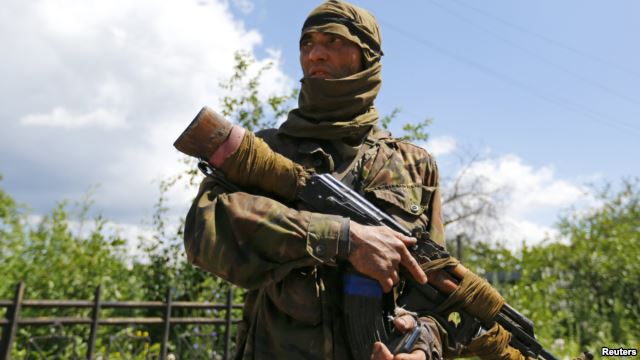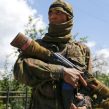
Central Asians in Syria and Ukraine: Which is the Greater Threat?
Publication: Eurasia Daily Monitor Volume: 11 Issue: 136
By:

Since Russia’s “annexation” of Crimea and the start of the Russia-backed “rebellion” in Donbas (eastern Ukrainian region encompassing Donetsk and Luhansk provinces), Central Asian countries have become concerned about their citizens joining the pro-Russia forces in Ukraine as “mercenaries.” Prior to the Ukraine crisis, the greatest fear for Central Asian governments was their citizens joining jihadists in Syria and Iraq, where about 100 Kazakhs, 100 Kyrgyz, two Uzbek battalions and several dozen Tajiks are fighting. However, now Central Asian republics are realizing that their citizens’ participation in the war in Ukraine is likely more consequential for their national security and sovereignty than their citizens fighting in Syria and Iraq.
Several reports have emerged recently of Kazakhs, Uzbeks, Turkmen and citizens of other former Soviet countries fighting with the pro-Russia forces in Ukraine. On July 7, a pro-Russia Turkmenistani soldier appeared in an interview next to a tank at a battlefield in Luhansk where bullet fire could be heard in the background (YouTube, July 7). The soldier said he was from Ashgabat and that he was fighting “to do what is right to protect the weak.” He added, “Although this is not my war, I came from Turkmenistan to protect children and civilians.” He then asked rhetorically, “Why can you not help? We are on the side of truth and will stand up for victory.”
In April, the secessionist “People’s mayor” of Slovyansk (city in eastern Ukraine, since liberated by government forces) said that his militia included “volunteers who came to us from Moldova, from Russia, from Belarus, from Kazakhstan, from the North Caucasus” (Voice of Russia, April 25). Similarly, a member of the “Eurasian Youth Union,” which organizes volunteers to support pro-Russia forces in eastern Ukraine, said that he contacted “thousands of people,” including from the Cossack community of eastern Kazakhstan (Izvestia, February 25). Thus far, however, there is no visual confirmation of Kazakhstani militants fighting in Ukraine, despite reports of their presence in the country. While no videos have emerged similar to the October 2013 video of more than 100 Kazakhs in Syria and July 2014 footage of more than 10 Kazakhs with the Islamic State in Syria and Iraq (ISIS), Kazakhstan’s foreign ministry is “paying attention” to reports of Kazakhstani citizens in Slovyansk (YouTube, October 23, 2013; jihadology.net, July 16; Tengrinews, April 25).
Meanwhile, in June 2014, media presented an image of an Uzbek fighter in Donetsk, Ukraine, thus confirming the presence of Uzbeks in the milieu of fighters from Central Asia and other former Soviet countries (Kyiv Post, June 25). One month later, an interview emerged of an Armenian who fought in Donetsk, but retreated after having taken part in losing battles against the Ukrainian army (RFE/RL, July 13). This fighter’s attitude summarizes the ideological reasons why fighters from the former Soviet Union are joining pro-Russian forces in Ukraine. He said, “I do not consider Russia a foreign country. I have the mentality of a Soviet person. My grandfathers fought for the Soviet Union and I am fighting for it.”
The ideology of this Armenian fighter comports with the way that Russia is promoting the conflict in Ukraine as a civilizational issue. According to Jamestown Foundation President Glen E. Howard, Russia is using the recruitment of non-Russians as a way of inviting Central Asians to join a new “world order” in which Central Asians can help “the new Russia” (Author’s interview, July 12). This “new Russia” defines itself in juxtaposition to the values that Western countries promote, such as gay rights and democracy, while also offering an alternative to the jihadist vision of a Taliban-style caliphate in Central Asia that would erase national borders.
This new Russian ideology is a threat to Central Asian sovereignty. If Central Asia’s native ethnic-Russian and pro-Russia populations identify more with President Vladimir Putin’s pan-Eurasian vision than with their country’s nationalistic policies, this could to lead greater popular support for Russian military, economic and political influence in Central Asia. Moscow hopes to embody such integrationist regional influence via its Eurasian Economic Union (EEU) project, which Russia, Kazakhstan and Belarus already joined and Kyrgyzstan and Armenia are likely to join soon. The EEU could evolve into a contemporary version of a Moscow-led order in Central Asia not too different from what existed during Soviet times.
On the ground, Russia is wasting no time in displaying its growing military preeminence in Central Asia, particularly now that the United States and its Western allies are withdrawing most of their troops from Afghanistan. In July, for example, Russia carried out military exercises involving 65,000 troops, including its forces based in Kyrgyzstan and Tajikistan (Voice of Russia, July 14). Russia may be readying for the possibility of having to redirect its forces to Central Asia in the future—be it to combat jihadist groups or to preserve “order” in case of instability, such as a secession crisis or ethnic conflict. And now, it will also likely have the ability to call upon the battle-hardened pro-Russia Central Asia mercenaries currently honing their skills in eastern Ukraine. These veterans of the fight for Donbas could, therefore, become an important element of Russia’s future military operations in Central Asia.




